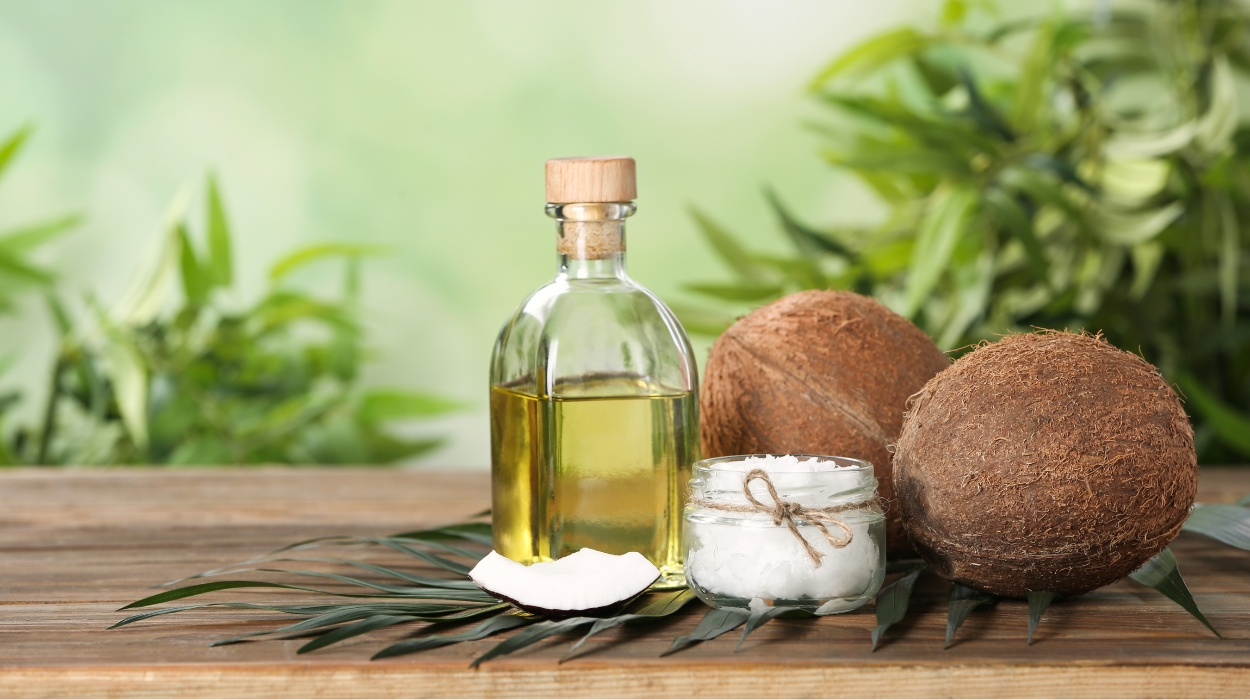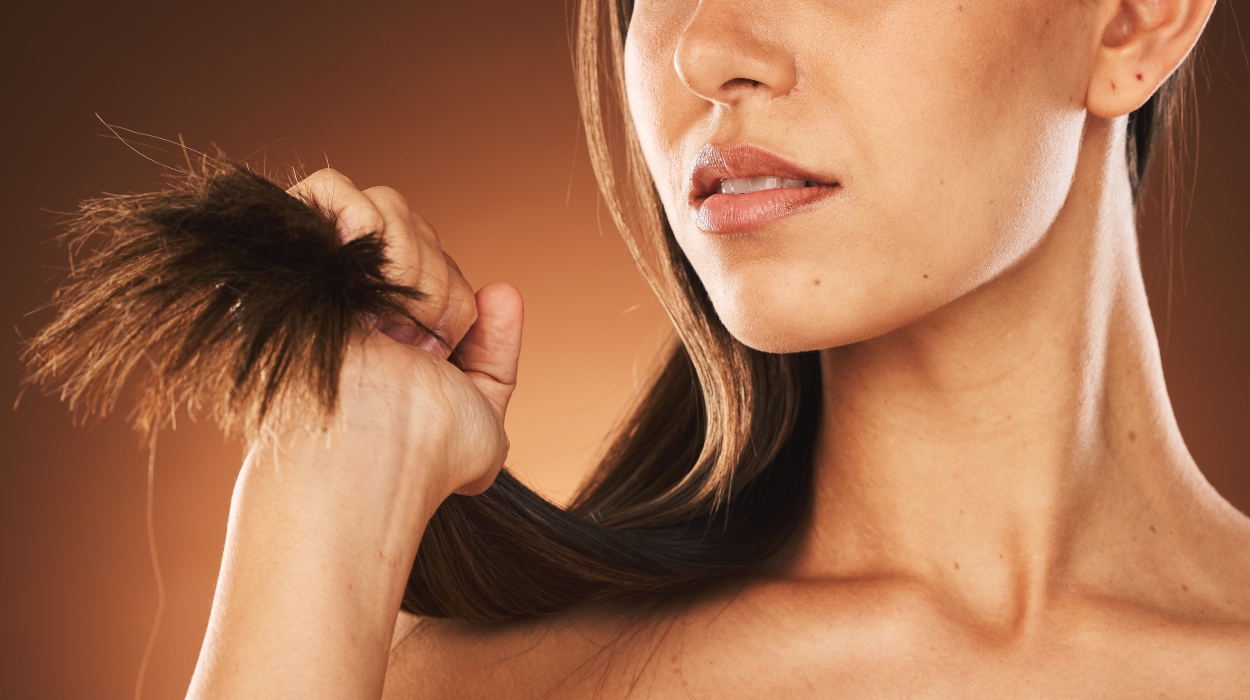Split ends are frustrating and common hair problems that many people face. Split ends not only cause dull and frizzy hair but can also hinder growth and overall health. Fortunately, there are several effective methods and practices you can incorporate to get rid of split ends. Whether you have short or long hair or straight or curly locks, you can implement practical steps to manage damaged hair.
In this piece, you will discover how to get rid of split ends. By applying the recommendations in this guide, you can maintain the overall health of your scalp and achieve luscious, damage-free locks.
Amidst several recommendations, you shall also discover the best fruit and vegetable supplements that have proven highly effective. Let’s dive into why split ends occur, and embark on a journey toward revitalized and resilient hair strands.
What To Do With Split Ends?
Do you want to know how to get rid of split ends overnight? Below are strategies that work:
- Use coconut oil hair masks.
- Drink plenty of water.
- Eat green leafy vegetables.
- Maintain a good hair care routine.
How To Get Rid Of Split Ends?
Coconut Oil Hair Mask

Coconut oil is known for its moisturizing and nourishing properties, alongside a natural oil like olive oil. These natural oils promote healthy hair and reduce the occurrence of split ends. However, opt for high-quality, unrefined coconut oil such as virgin oil.[1] You may read about the benefits of coconut oil for more information about its usefulness apart from promoting good hair.
Drink Plenty Of Water
Drinking sufficient water is a hair treatment strategy that helps maintain optimal hydration levels in the body, especially the hair follicles. Since well-hydrated follicles are more likely to produce hyoid hair, this can help fix split ends in the long run.
It’s understandable if you wonder how much water you should drink. This is because drinking water alone isn’t sufficient. You must incorporate a balanced diet rich in nutrients[2] to complement the benefits of being hydrated. This may include fish oil, olive oil, brown rice, folic acid sources, or sweet almond oil.
Eat Green Leafy Vegetables
Green leafy vegetables like spinach are rich in vitamins, minerals, and antioxidants. Leafy greens also contain nutrients like vitamins E, C, A, and K, as well as iron, calcium, and folate. These nutrients support the production of healthy strands and promote hair growth.
Maintain A Healthy Hair Care Routine
Your knowledge of how to get rid of split ends is incomplete if you don’t maintain a good hair care routine. Thus, take steps such as keratin treatment, to keep your hair healthy and prevent damage from occurring in the future. This includes a leave-in conditioner, using a wide-toothed comb to detangle wet hair, and minimizing heat styling tools.
What Are Split Ends?

Split ends refer to the condition where the hair strand splits into two or more separate strands at the end. They occur when the protective outer layer, known as the cuticle, becomes damaged or weakened. Due to various factors, such as heat styling, chemical treatments, excessive brushing, and exposure to sun and pollution, the cuticle becomes weak. This may eventually cause frayed ends. Meanwhile, the cuticle acts as a shield, protecting the inner layers from environmental stressors and maintaining its moisture balance.
Why Do I Have Split Ends?
Unfortunately, hair splits can be highly embarrassing, so people often ask how to get rid of split ends at home. Nevertheless, you need to understand the causes to apply the best hair treatments.
- Chemical treatments: Many chemicals break down the hair’s amino acid structure, including the keratin protein that provides strength and elasticity. These chemicals break the disulfide bonds in the hair, altering its natural structure. Some treatments also alter the pH balance of the hair. For example, hair dyes and bleaches are typically alkaline, while relaxers and perms are highly acidic.[3] This drastic change in pH can disrupt the natural balance and weaken the cuticle layer. However, you may use deep conditioning treatments like leave-in conditioners.
- Environmental factor: Exposure to the sun’s ultraviolet (UV) rays can damage the hair,[4] leading to dryness, brittleness, and split ends. This exposure may also result in high temperatures and humidity levels. This will dehydrate the hair, causing it to become dry and prone to split ends.
- Lack of moisture: A dry scalp usually has a rough and coarse texture, increasing friction between the hair strands. The lack of moisture exacerbates the friction when the hair rubs against itself or surfaces. The roughened texture makes detangling more challenging, leading to potential hair breakage and split ends during combing or brushing.
- Genetic factor: While genetics alone may not directly cause split ends, certain inherited characteristics can make the hair more prone to splitting. For instance, genes can influence the structure and quality of the keratin protein being produced. Hair density also varies genetically.[5] Thus, low-density or sparse follicles are more susceptible to splitting.
Tips To Prevent Split Ends
Do you want to know how to get rid of split ends without cutting hair? These tips will provide the helpful information you may need.
Avoid Dyeing Your Hair
Hair dye contains chemicals, such as ammonia and peroxide, which can strip the hair of its natural oils and moisture. Over time, repeated dyeing can worsen the condition of your hair and lead to more damage. Thus, you should minimize the frequency of dyeing and give very damaged hair enough time to recover.
Regular Hair Trims
Having your hair trimmed regularly will help maintain a consistent hair length by removing the oldest and most damaged portions. It prevents split ends from traveling up the hair shaft and causing further hair damage. People often schedule regular hair trims every 6-8 weeks.
Protect Your Hair From Heat
Heat tools like blow dryers, straighteners, and curling irons can cause damage, especially to the hair cortex.[6] If it’s necessary to use hot tools, apply a heat protectant spray or serum before starting. This will help to create a barrier between your hair fibers and the heat.
Protect Your Hair From Environmental Stressors
Exposure to sun, wind, and pollutants can damage the hair, leading to split ends. Thus, protect your hair by wearing a hat or using hair products with SPF when spending extended periods outdoors.
Do Some People Have More Split Ends Than Others?
Split ends can happen to anyone. However, a National Library of Medicine study reported[7] that Afro-textured hair is more risky. This further confirms that genetic factors are also responsible for scalp damage in individuals.
Differences in individuals’ hair types may also be responsible for the varying natural moisture and elasticity levels. People with naturally dry or brittle hair are more susceptible to split ends because they lack the necessary moisture. More so, extrinsic factors, such as hair care practices and environment, may cause some people to have more split ends than others.
Conclusion
Split ends are common hair concerns, but applying good hair practices can prevent your hair from such a situation. Avoid excessive heating, use of chemical straightening, and hair dehydration. You may also save your hair from environmental factors by wearing a hat outdoors. Hopefully, other techniques discussed in this article are enough to repair split ends.
Frequently Asked Questions
Split ends are neither deadly nor life-threatening. However, you must treat them, as they will continually yield a less desirable appearance.
The frequency of hair washing varies depending on several factors, such as hair type, personal preference, and lifestyle. Thus, washing every 2-3 days or even once a week might be appropriate for dry hair.
Drinking excess water doesn’t only have a positive effect on your hair but also helps to hydrate your skin. A well-hydrated skin will be free of wrinkles, dryness, and breakouts.
Yes, it can. However, look for shampoos that are specifically formulated to hydrate and moisturize the hair. Such shampoos often contain almond oil, fish oil, shea butter, or hyaluronic acid.
Split ends are characterized by splitting or fraying of the hair shaft. You may experience other symptoms, such as damaged hair, uneven hair length, poor hair color, breakage, tangling, and dull appearance.
Regular trims are essential for removing split ends and preventing them from worsening. It is generally recommended to schedule hair trims every 6-8 weeks to maintain the appearance of your hair.
Split ends themselves do not directly cause baldness. Baldness is often caused by other factors such as genetics, hormonal changes, medical conditions, and certain medications.
Some particular fruits and vegetables are beneficial for hair health. They include; spinach, sweet potatoes, citrus fruits, argan oil source, berries, avocado, and carrots.
 Expert's opinion
Expert's opinion
